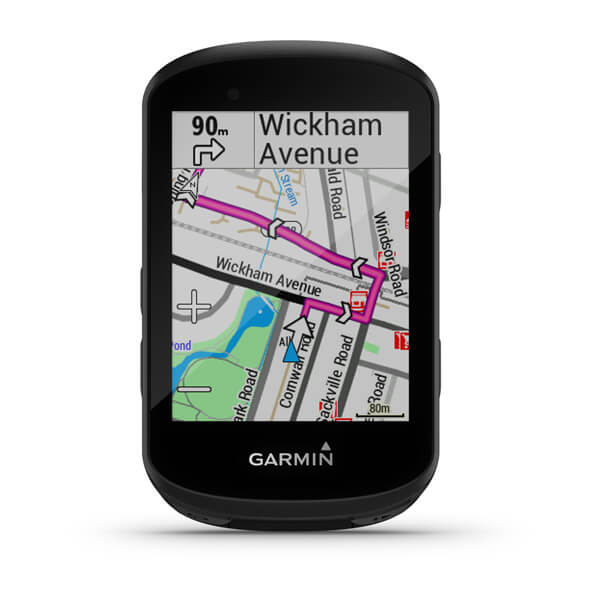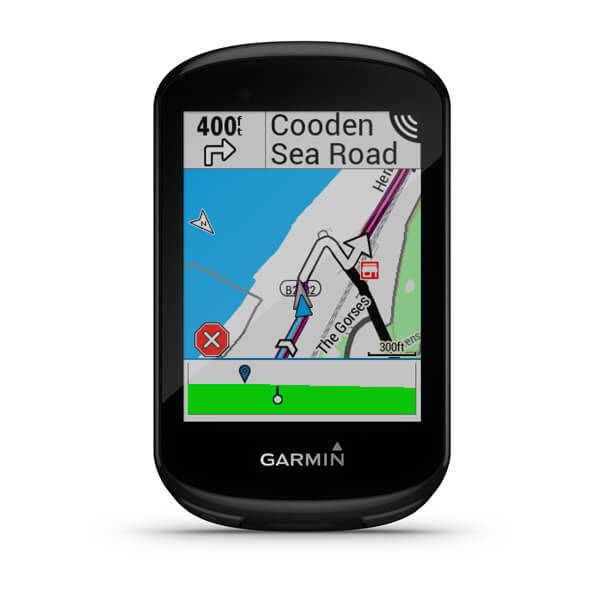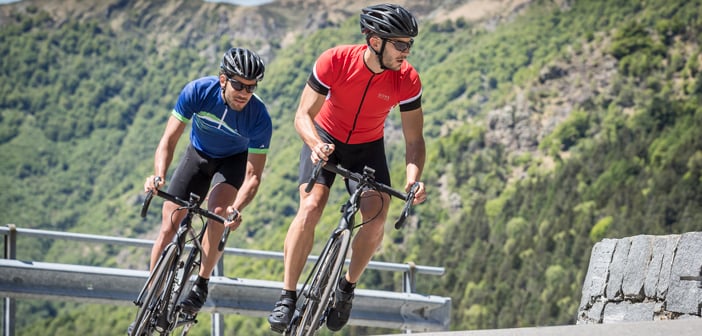
What Every Cyclist Should Know – V02 Max and Aerobic Performance on Your Garmin
By Firstbeat
VO2 max is the metric that describes your cardiorespiratory fitness and aerobic performance capacity. It is closely tied to your ability to sustain performance for longer periods of time. This makes thinking about performance capacity in terms of VO2 max very attractive to cyclists, runners, triathletes and other endurance athletes, who often rely on it to assess the productivity of their training efforts.
This article will get you up to speed on what VO2 max measures and how it is measured, how VO2 max is used to personalize feedback and provide new training insights, and gives you a quick introduction to ways to boost your own VO2 max. The cyclist with the highest VO2 max doesn’t always win the race, but certainly needs a relatively high VO2 max to be competitive.
Measuring VO2 max:
Direct measurement of VO2 max requires a laboratory setting. It involves wearing a respiratory mask while running on a treadmill or cycling on a stationary bike with gradually increasing intensity. The respiratory mask captures and analyzes the composition of air coming in and going out of your lungs. The amount of oxygen you exhale is subtracted from the quantity of oxygen you inhale to reveal how much oxygen is being imported into your system.
As the intensity of your effort increases, so does the amount of oxygen you use until eventually your oxygen utilization rate plateaus. When achieved properly with the help of standardized testing protocols, this eventual plateau in oxygen consumption signals that you have reached your maximum capacity to use oxygen. In other words, you’ve reached your VO2 max.
Let’s take a quick moment to unpack why you need oxygen in the first place.
The air you inhale fills your lungs, where oxygen is extracted and mixed with your blood supply. Your heart pumps this oxygenated blood through your arteries to your muscles, where, when available, it is used as a catalyst facilitating the transformation of nutrients into the fuel molecules your muscles need to contract.
Keeping tabs on your aerobic performance capacity provides valuable information about how you are doing and the effectiveness of your training activities. Heading into a physio lab for regular direct VO2 max testing, however, is expensive and impractical even for top athletes. The time, energy and resources necessary for maximal exertion testing in a laboratory is usually better spent elsewhere.
Your Garmin device utilizes an indirect approach to assessing your VO2 max with the help of advanced performance analytics from Firstbeat. The analytics used to provide this insight are built on a scientifically proven understanding of the relationship between internal and external workloads and human physiology. Internal workload simply refers to how hard your body is working relative to maximum capacity and can be derived through real-time analysis of your heart rate data. External workload describes what you are doing and achieving in the external world. To calculate VO2 max during cycling activities, external workload data is provided by your power meter and is measured in watts.
In a controlled environment with specified test protocols, the relationship between internal workload, external workload and fitness is relatively straight forward. As your cardiorespiratory fitness (VO2 max) improves, a lower percentage of your internal workload capacity is required to produce the same number of watts.
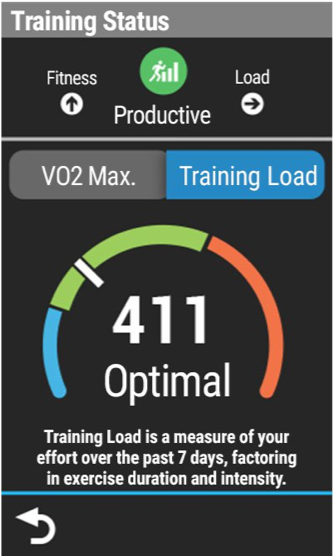
In real-world training conditions and environments, the trick is to be able to recognize when that relationship is meaningful and when it’s not. Assessing your VO2 max reliably from real-world activity data requires smart analytics capable of automatically recognizing the portions of your activity that truly reflect your abilities. This means, among other things, identifying and eliminating segments where your aerobic energy pathways are still warming up to increases in energy demand and those times when fatigue and cardiac drift are influencing your results.
Garmin cycling computers only calculate VO2 max during cycling. If you are, however, recording your cycling activities with a Garmin multisport watch, it can also calculate your VO2 max when you are out for a run. The primary difference in the analysis for running versus cycling is the source of external workload data. When you are out for a run with your watch, external workload data is provided in the form of moving speed from your device’s onboard GPS as opposed to cycling applications, which use data from your power meter.
The reason movement speed from GPS or other speedometer data isn’t a reliable source of external workload data for cycling is cycling speed is so substantially impacted by gearing and elevation grades compared to running.
If you are an active cyclist and runner, you will notice that you have one VO2 max for cycling and a similar but slightly different VO2 max value for running. This activity type-based variation is normal in both direct and indirect VO2 max measurements and is simply the result of different muscle groups being used and sport-specific training adaptations.
In addition to being able to see your VO2 max as a number, those same screens will also let you know how your fitness compares to other people based on your gender and age range. The contextual value of these two factors comes from differences in general body composition between men and women, and the fact that cardiorespiratory fitness typically declines with age.
Heat, humidity and altitude:
The Garmin Edge 530 and Garmin Edge 830 cycling computers are two of the first training devices to utilize Firstbeat’s sixth-generation VO2 max detection analytics. This means improved reliability in increasingly challenging environmental conditions.
Significant and sudden increases in heat, humidity and elevation can independently, and in combination, have a negative impact on performance. At higher altitudes, there is less oxygen available in the air, and it becomes more difficult to supply the oxygen you need to produce aerobic energy — the key to sustainable performance. Increases in heat and humidity mean your body must work harder to maintain a normal, functional body temperature, and that means less energy can be used strictly for performance.
Exposure to challenging environmental conditions triggers physiological adaptations that help you perform better under these conditions. This is the acclimatization process. By recognizing the impact of environmental factors on your performance, it becomes possible to monitor how well adapted you are to your current situation. It also means that your device can recognize the difference between a change in performance capacity stemming from an inadequate recovery or decreased fitness and a decline in performance due to a sudden increase in temperature or altitude.
Putting VO2 max to work for you:
While easy access to your cardiorespiratory fitness level certainly provides some useful insight on its own (and maybe bragging rights on social media and among your peers), your VO2 max isn’t just a number that sits in your watch, cycling computer, Connect app or dashboard.
Your VO2 max is actively used behind the scenes in conjunction with trends in your training load and activity history to calibrate, personalize and enhance the meaningfulness of other feedback you get from your Garmin watch or cycling computer.
For example, VO2 max plays a critical role in identifying the currently optimal training load. The fitter you are, the higher your VO2 max and the harder you need to challenge yourself to maintain and improve your fitness level. This fundamental training principle is built into and automatically considered when determining the personally optimal range of your training load. It also reveals when you aren’t being challenged enough, and when overdoing it is increasing your chances of burnout and injury.
Training status is a prime example of how VO2 max can be used to provide new, big-picture insights. Your current training status is an interpretation of how training is going from the perspective of improving your cardiorespiratory fitness and aerobic performance capacity.
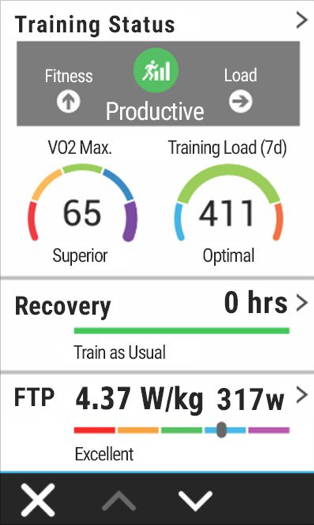
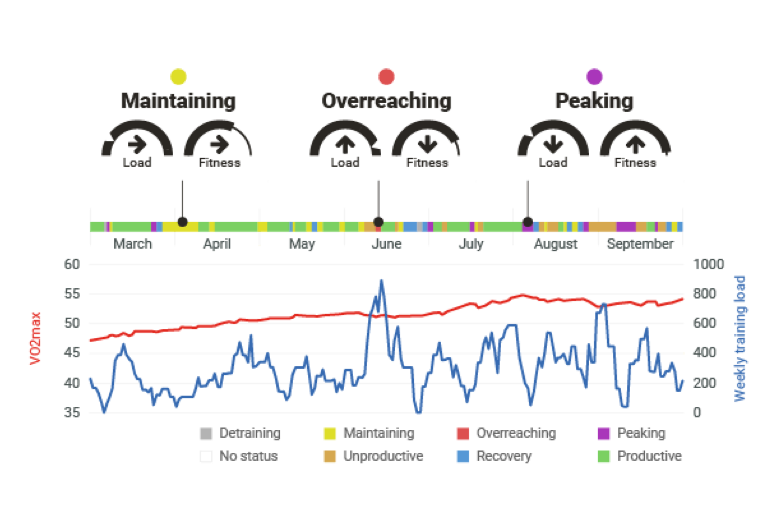
When your training status is productive, it means that your workouts are simultaneously challenging enough for you and are paying dividends in the form of improved aerobic performance capacity. An unproductive status lets you know when your performance capabilities are on the decline despite maintaining an otherwise sensible training load. It could be time to lighten up, schedule more time between hard workouts to facilitate recovery, or keep an eye on stress levels, nutrition and other aspects of life that might be interfering with your progress.
You can also see when you are maintaining your current level, and when you are peaking, detraining, recovering or overreaching. All this becomes available thanks to the ability to quantify, see, and interpret your fitness and workload.
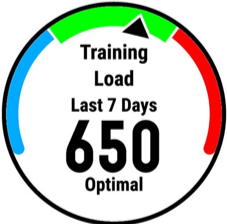
VO2 max also provides perspective to help interpret, understand and predict how you are personally affected by the physiological impact of specific training activities. A training ride that was challenging enough to trigger adaptation and improve your fitness at the start of a training program may not be stimulating enough to help you improve later in your training program.
This reality is reflected in how VO2 max is used to personalize training effect feedback and recovery time predictions. The former uses performance data to predict how an activity will influence the development of future capacities, and the latter helps you maximize the benefit of each workout by letting you know when you will be ready for your next hard challenge.
How to improve your VO2 max (and performance):
It would be amiss to introduce the subject of VO 2 max and its relevance to performance without also saying something about how you can improve it. The specificity principle of training reminds that to enhance a specific aspect of your performance the work you do needs to be aligned with your ambition.
If you want to improve your maximum bench press, you need to challenge yourself with heavier weights. In the same way, it is your focus on high-intensity efforts that have the greatest impact on the development of your VO2 max and aerobic performance capacity. Low-intensity efforts enhance recovery and support the development of other aspects of performance such as muscular endurance, but ultimately, it is the high-intensity work you do that improves your maximum ability to produce energy aerobically.
HIIT sessions are a popular option for those eager to boost their VO2 max in a hurry, particularly for those who are just getting started or are coming back from an extended training break. The mixing of high-intensity efforts with lighter ones gives you a chance to recover and ultimately engage in more high-intensity work than you otherwise might be able to tolerate.
Tempo rides are another popular building block in the cyclist’s training arsenal that can positively impact your VO2 max. These relatively steady-state, high-intensity sessions focus on pushing yourself at the level of effort that is only sustainable for around 45 minutes to 1 hour before becoming exhausted.
Improvements in VO2 max typically arrive in the form of increased stroke volume (the amount of blood pumped with each heartbeat), increases in blood supply, and adaptations in your muscles at a cellular level that help you store and transfer energy more efficiently. However, it’s important to remember that VO2 max is the amount of oxygen your body can use in a single minute per kilogram of body weight. This means that being overweight or obese makes it practically impossible to reach the upper limits of your VO2 max potential.
Genetic factors are responsible for roughly 50% of both your current VO2 max and its trainability, meaning how your fitness changes in response to training. The good news is that practically anyone can improve their VO2 max with regular physical activity performed with enough intensity to challenge your limits. Well-trained athletes who have been actively competing seriously for many years typically have the least to gain because they are already likely near their maximum individual potential. This is great news for everyone else.
